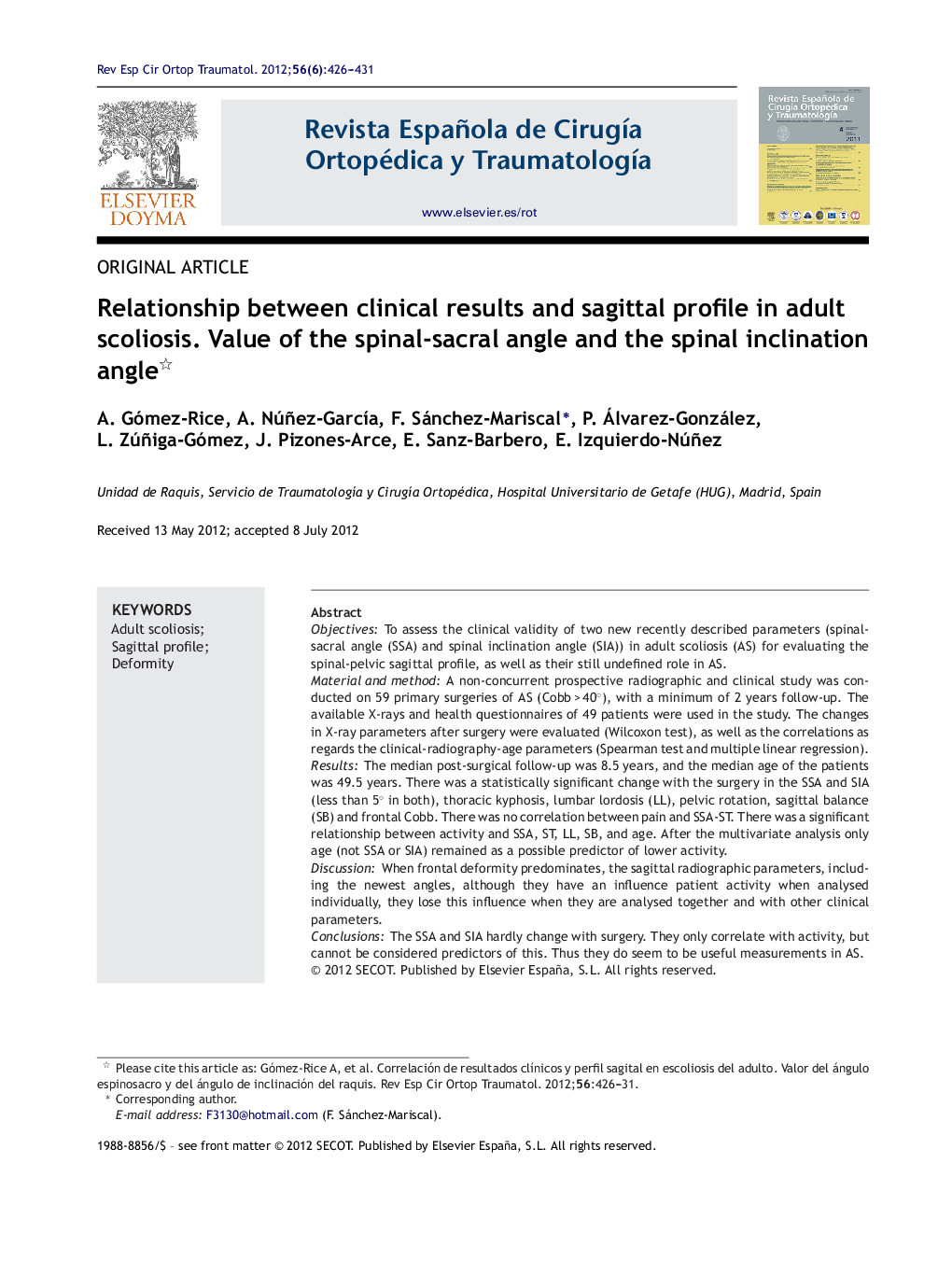| Article ID | Journal | Published Year | Pages | File Type |
|---|---|---|---|---|
| 4087344 | Revista Española de Cirugía Ortopédica y Traumatología (English Edition) | 2012 | 6 Pages |
ObjectivesTo assess the clinical validity of two new recently described parameters (spinal-sacral angle (SSA) and spinal inclination angle (SIA)) in adult scoliosis (AS) for evaluating the spinal-pelvic sagittal profile, as well as their still undefined role in AS.Material and methodA non-concurrent prospective radiographic and clinical study was conducted on 59 primary surgeries of AS (Cobb > 40°), with a minimum of 2 years follow-up. The available X-rays and health questionnaires of 49 patients were used in the study. The changes in X-ray parameters after surgery were evaluated (Wilcoxon test), as well as the correlations as regards the clinical-radiography-age parameters (Spearman test and multiple linear regression).ResultsThe median post-surgical follow-up was 8.5 years, and the median age of the patients was 49.5 years. There was a statistically significant change with the surgery in the SSA and SIA (less than 5° in both), thoracic kyphosis, lumbar lordosis (LL), pelvic rotation, sagittal balance (SB) and frontal Cobb. There was no correlation between pain and SSA-ST. There was a significant relationship between activity and SSA, ST, LL, SB, and age. After the multivariate analysis only age (not SSA or SIA) remained as a possible predictor of lower activity.DiscussionWhen frontal deformity predominates, the sagittal radiographic parameters, including the newest angles, although they have an influence patient activity when analysed individually, they lose this influence when they are analysed together and with other clinical parameters.ConclusionsThe SSA and SIA hardly change with surgery. They only correlate with activity, but cannot be considered predictors of this. Thus they do seem to be useful measurements in AS.
ResumenObjetivosEvaluar la validez clínica en EA de 2 nuevos parámetros (ASS y ST) descritos recientemente para la evaluación del perfil sagital espinopélvicos, y cuyo papel en EA no está aún definido.Material y métodoAnálisis prospectivo (no concurrente) radiográfico y clínico de 59 cirugías primarias de EA (Cobb > 40°), mínimo 2 años de seguimiento. Para este trabajo dispusimos de radiografías y cuestionarios de salud de 49 pacientes. Se evaluó el cambio de los parámetros radiográficos tras cirugía (test Wilcoxon) y la correlación resultados clínicos-radiográficos-edad (test de Spearman y regresión lineal múltiple).ResultadosMediana de seguimiento postoperatorio 8,5 años. Mediana edad 49,5 años. Hubo cambio estadísticamente significativo con la cirugía en ASS y ST (en ambos inferior a 5°), cifosis torácica (CT), lordosis lumbar (LL), rotación pélvica (RP), balance sagital (BS) y Cobb frontal. No hubo correlación entre dolor y ASS-ST. Hubo correlación significativa entre actividad y ASS, ST, LL, BS) y edad. Tras análisis multivariante solo la edad (ni ASS ni ST) persistió como posible predictor de menor actividad.DiscusiónCuando predomina la deformidad frontal, los parámetros radiográficos sagitales, incluidos los más novedosos ángulos, si bien sí influyen en la actividad del paciente cuando se analizan de forma aislada, pierden esta influencia cuando se analizan en conjunto y junto a otros parámetros clínicos.ConclusionesLos valores de SSA y ST varían escasamente con la cirugía. Solo se correlacionan con la actividad pero no pueden considerarse predictores de la misma. No parecen pues medidas de utilidad en EA.
